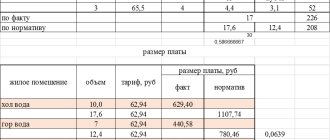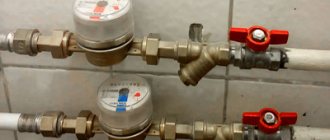As in previous years (for example, in 2021), the standard for heating hot water in the current 2022 is determined by sanitary and epidemiological requirements and is clearly outlined in SanPiN (Sanitary Rules and Norms), which in the Russian Federation have the status of a regulatory document. They establish both hygienic requirements for the quality of water supplied to citizens’ homes and temperature standards.
Boiler
Other ways to determine the amount of heat
Let us add that there are also other methods by which you can calculate the amount of heat that enters the heating system. In this case, the formula is not only slightly different from those given below, but also has several variations.
As for the values of the variables, they are the same as in the previous paragraph of this article. Based on all this, we can confidently conclude that it is quite possible to calculate the heat for heating on your own. However, one should not forget about consulting with specialized organizations that are responsible for providing housing with heat, since their methods and principles of calculations may differ, significantly, and the procedure may consist of a different set of measures.
If you intend to equip a “warm floor” system, then prepare for the fact that the calculation process will be more complex, since it takes into account not only the characteristics of the heating circuit, but also the characteristics of the electrical network, which, in fact, will heat the floor. Moreover, the organizations that install this kind of equipment will also be different.
Note! People often encounter the problem of converting calories into kilowatts, which is explained by the use of a unit of measurement in many specialized manuals, which is called “C” in the international system. {amp}gt;
In such cases, it is necessary to remember that the coefficient due to which kilocalories will be converted to kilowatts is 850
In such cases, it is necessary to remember that the coefficient due to which kilocalories will be converted into kilowatts is equal to 850. In simpler terms, one kilowatt is 850 kilocalories. This calculation option is simpler than those given above, since the value in gigacalories can be determined in a few seconds, since a Gcal, as noted earlier, is a million calories.
Traditionally, now we find out what each of these variable values means.
1. V1 is the flow rate of the working fluid in the supply pipeline.
2. V2 – a similar indicator, but in the return pipeline.
3. 100 is the number by which the value is converted to a percentage.
4. Finally, E is the error of the accounting device.
According to operational requirements and standards, the maximum permissible error should not exceed 2 percent, although in most meters it is somewhere around 1 percent.
As a result, we note that a correctly calculated Gcal for heating can significantly save money spent on heating the room. At first glance, this procedure is quite complicated, but - and you have seen this personally - if you have good instructions, there is nothing difficult about it.
That's all. We also recommend watching the thematic video below. Good luck in your work and, as usual, have a warm winter!
- Calorie (international calorie) (Russian designation: cal; international: cal), 1 cal = 4.1868 J exactly.
- Thermochemical calorie (Russian designation: calTH; international: calth), 1 calTH ≈ 4.1840 J.
- 15-degree calorie (Russian designation: cal15; international: cal15), 1 cal15 ≈ 4.1855 J.
Previously, the calorie was widely used to measure energy, work, and heat; “caloric value” was the heat of combustion of fuel. At present, despite the transition to the SI system, in thermal power engineering, heating systems, and public utilities, a multiple unit of measurement of the amount of thermal energy is often used - gigacalorie (Gcal) (109 calories).
In addition, the calorie is used in estimating the energy value (“caloric content”) of foods. Energy value is usually indicated in kilocalories (kcal).
Megacalorie (1 Mcal = 106 cal) and tercalorie (1 Tcal = 1012 cal) are also used to measure the amount of energy.
What is Gcal?
We should start with a related definition. A calorie refers to the specific amount of energy required to heat one gram of water to one degree Celsius (at atmospheric pressure, of course). And due to the fact that from the point of view of heating costs, say, at home, one calorie is a tiny amount, gigacalories (or Gcal for short), corresponding to one billion calories, are used for calculations in most cases. We've decided on this, let's move on.
The use of this value is regulated by the relevant document of the Ministry of Fuel and Energy, published back in 1995.
So, what is a gigacalorie if we “transform” it into values that are more familiar to us? See for yourself.
1. One gigacalorie is equal to approximately 1,162.2 kilowatt-hours.
2. One gigacalorie of energy is enough to heat a thousand tons of water to +1°C.
What if the equipment breaks down
If the heater breaks down, then utility bills for heating will not increase or decrease. Therefore, it is important to quickly return it to service. In this situation, payers must immediately inform the management company employees about the breakdown. After receiving the application, the legal entity must immediately send specialists to restore the operation of the water heater.
Residents are also responsible for purchasing equipment.
Is it legal to charge for this?
When people see an additional column on a check, they wonder if this is legal. Some immediately contact company employees and clarify what the new column means and why they need to pay. And some simply don’t pay money for it.
However, such actions by consumers will be considered illegal, since the obligation to pay for water heating is specified in the articles of the Housing Code. Also, the legality of demanding payment for this is also indicated in Decree of the Government of the Russian Federation No. 354 of June 6, 2011[1].
How is water heating calculated in housing and communal services receipts?
The tariff for the supply of hot water is regulated by section No. 2, paragraph 4, resolution 406. The general tariff includes the following components: hot water, transportation by a central pipeline, maintenance of equipment connecting the intra-house system to the hot water supply.
A two-component tariff consists of a tariff for cold water and a component for heating (thermal energy). The following formula is used to calculate water heating in the housing and communal services receipt:
Sgv = Sхv + Ste
Here, the cost of hot water is equal to the volume of cold water multiplied by the tariff, plus the cost of thermal energy required to heat a given amount of water to the desired temperature. The heating temperature should be from 60 to 75 degrees.
First of all, let's talk about cold water. The payment slip already has a cold water column, but this is for use, delivery of cold, unheated water. So you don’t pay twice for HB, these are two different types of services.
The thermal energy tariff component consists of the following:
- the cost of 1 Gcal of a unit of thermal energy adopted by law;
- financial costs of the organization providing the service for the maintenance and servicing of the pipeline from the thermal power plant to the operational entrance;
- accounting for heat loss along the hot water transportation route;
- transportation price.
FC component is the amount of energy spent on heating the volume of water used by the consumer. The volume is determined not by metering devices, but by consumption standards adopted by law.
If heat meters are installed in the apartment, the cost of thermal energy is equal to the volume of hot water multiplied by the thermal energy tariff.
If there are individual metering devices, water heating in receipts is calculated using the formula:
Qgv = V x Npv (5)
, Where
- V – volume of hot water according to meter readings,
- Npv – standard for heating.
The latter figure will average 0.05-0.07 Gcal/m3.
Heat meters
Now let’s find out what information is needed in order to calculate the heating. It's easy to guess what this information is.
1. Temperature of the working fluid at the outlet/inlet of a specific section of the pipeline.
2. The flow rate of the working fluid that passes through the heating devices.
Consumption is determined through the use of heat metering devices, that is, meters. These can be of two types, let’s get acquainted with them.
Vane meters
Such devices are intended not only for heating systems, but also for hot water supply. Their only difference from those meters that are used for cold water is the material from which the impeller is made - in this case it is more resistant to elevated temperatures.
As for the mechanism of operation, it is almost the same:
- due to the circulation of the working fluid, the impeller begins to rotate;
- the rotation of the impeller is transmitted to the accounting mechanism;
- transmission is carried out without direct interaction, but with the help of a permanent magnet.
Despite the fact that the design of such meters is extremely simple, their response threshold is quite low, moreover, there is reliable protection against distortion of readings: the slightest attempts to slow down the impeller through an external magnetic field are stopped thanks to an antimagnetic screen.
Devices with a difference recorder
Such devices operate on the basis of Bernoulli's law, which states that the speed of a gas or liquid flow is inversely proportional to its static movement. But how does this hydrodynamic property apply to calculations of working fluid flow? It’s very simple - you just need to block its path with a retaining washer. In this case, the rate of pressure drop on this washer will be inversely proportional to the speed of the moving flow. And if the pressure is recorded by two sensors at once, then the flow can be easily determined, and in real time.
Note! The design of the meter implies the presence of electronics. The vast majority of such modern models provide not only dry information (temperature of the working fluid, its consumption), but also determines the actual use of thermal energy. The control module here is equipped with a port for connecting to a PC and can be configured manually.
Many readers will probably have a logical question: what to do if we are not talking about a closed heating system, but about an open one, in which selection for hot water supply is possible? How to calculate Gcal for heating in this case? The answer is quite obvious: here pressure sensors (as well as retaining washers) are installed simultaneously on both the supply and the “return”. And the difference in the flow rate of the working fluid will indicate the amount of heated water that was used for domestic needs.
We recommend reading: Do-it-yourself car air conditioning cleaning
Hot water law
The law on hot water supply was adopted in 2013. Government Decree No. 406 states that users of a central heating system are required to pay a two-part tariff. This suggests that the tariff was divided into two elements:
This is how DHW appeared on the receipt, that is, the thermal energy spent on heating cold water. Housing and communal services specialists came to the conclusion that risers and heated towel rails, which are connected to the hot water supply circuit, consume thermal energy to heat non-residential premises. Until 2013, this energy was not taken into account in receipts, and consumers used it free of charge for decades, since the air in the bathroom continued to be heated outside the heating season. Based on this, officials divided the tariff into two components, and now citizens have to pay for hot water.
Heating in the bill - what is it?
What is heating is one of the frequently asked questions. The document contains 2 columns: thermal water supply (DHW) and heating. What is hot water supply? It is hot water supply. But people don't understand why they have to deposit money twice. But in reality everything is different. DHW is not warm water, but heat energy that is spent by housing and communal services to bring the liquid to the desired temperature. Therefore, a double tariff was introduced for hot water supply and for consumed energy.
This tariff was established due to the fact that additional energy is expended to achieve normal temperature. Previously, fuel consumption was not taken into account when calculating utility bills, and money was charged for this only during the heating season. Because of this, during this period, people’s expenses for heating and heating increased greatly. To prevent people's costs from increasing sharply, the Government divided the costs spent on achieving normal temperatures for the whole year.
Gigacalorie
As units of the amount of heat in technology, the joule (J), international calorie (cal) and multiple units are accepted: kilocalorie (kcal), megacalorie (Mcal), gigacalorie (Gcal): 1 cal 4 1868 J (exactly) 4 19 J; 1 kcal 1000 cal 4 19 kJ; 1 Mcal 1000 kcal 1,000,000 cal 4 19 MJ; 1 Gcal 1000 Mcal 1,000,000 kcal 1,000,000,000 cal 4 19 GJ.
The most important indicator characterizing a boiler room in the heat supply system to consumers is its thermal power (performance) - the total maximum power for all types of coolants supplied by the boiler room to consumers, expressed in gigacalories per hour.
Specific strength, unit - kilogram-force-centimeter per gram square meter per kilogram-force square centimeter per kilogram-force kilogram-force-second per square meter kilogram per second-meter kilogram-force per meter kilogram-force-meter per square centimeter kilogram-force centimeter per square centimeter Darcy kilogram per hour per meter-millimeter of water kilogram per hour per meter-0 1 atmosphere gram per hour per meter-millimeter of mercury cubic meter per hour per meter - millimeter of water teracalorie gigacalorie megacalorie kilocalorie calorie calorie thermochemical calorie per gram kilocalorie per kilogram calorie per gram degree Celsius kilocalorie per kilogram degree Celsius calorie per gram kelvin kilocalorie per kilogram kelvin kilogram-force meter per kilogram degree Celsius calorie per second kilocalorie per hour megacalorie per hour kilocalorie per hour per square meter megacalorie per hour per square meter kilocalorie per hour per cubic meter megacalorie per hour per cubic meter kilocalorie per hour per square meter-degree Celsius calorie per second per square centimeter-degree Celsius kilocalorie per hour per meter-degree Celsius calorie per second per centimeter degree Celsius ohm-square millimeter per meter curie curie per kilogram curie per gram curie per cubic meter curie per liter curie per milliliter curie per square meter curie per square centimeter rad kgf cm/g M2/KGS CM2/KGS kgf s / m2 kg / ( s-m) kgf / m kgf m / cm2 kgf cm / cm2 d KG / ( H - M - MM WOD.
In cases where great precision is not required, values are given in rounded figures. The same applies to the gigacalorie, since peak water boilers are labeled in this unit in terms of heating output.
The amount of heat is expressed in gigajoules or gigacalories. The latter unit continues to be widely used due to the ease of transition to this unit from the unit of mass and temperature.
Thus, the cost of heat transport consists of a number of cost items associated with the operation of heat pipelines and pumping substations; it fluctuates depending on local conditions. For example, in the Moscow Heating Network the cost of transporting one gigacalorie is 18 kopecks.
How to convert kW to Gcal/h
Key indicator for converting data from kilowatts to calories:
1 kW = 0.00086 Gcal/hour
To find out how many Gcal is obtained, you need to multiply the available number of kW by a constant value, 0.00086.
Let's look at an example. Suppose you need to convert 250 kW into calories.
250 kW x 0.00086 = 0.215 Gcal/hour.
(More accurate online calculators will show 0.214961).
To ensure 100% reliability of the heating system, a good solution would be to install an electric boiler along with a solid fuel boiler. It is quite possible to assemble such a structure with your own hands and thereby save money.
Instructions for assembling an electrolyzer with your own hands are presented here.











